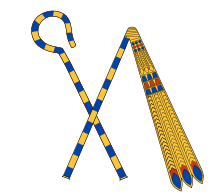
Back El cayado y el mayal Spanish Cajado e mangual Portuguese Ґирлиґа і ціп Ukrainian Móc và néo Vietnamese


| ||
| crook in hieroglyphs | ||
|---|---|---|
| ||
| "flail" in hieroglyphs | ||
|---|---|---|
The crook and flail (heka and nekhakha) were symbols used in ancient Egyptian society. They were originally the attributes of the deity Osiris that became insignia of pharaonic authority.[1] The shepherd's crook stood for kingship and the flail for the fertility of the land.[1]
The earliest known example of a crook is from the Gerzeh culture (Naqada II), and comes from tomb U547 in Abydos [citation needed]. By late Predynastic times, the shepherd's crook was already an established symbol of rule. The flail initially remained separate, being depicted alone in some earliest representations of royal ceremonial. Approximately by the time of the Second Dynasty, the crook and flail became paired.[citation needed]
The only extant pharaonic examples of both the crook and flail come from the Tomb of Tutankhamun.[2] Their staffs are made of heavy bronze covered with alternating stripes of blue glass, obsidian, and gold, while the flail's beads are made of gilded wood.[3]
- ^ a b Steele, Philip (2002). Ancient Egypt. The Rosen Publishing Group. p. 12. ISBN 1435851730.
- ^ Cite error: The named reference
HCMwas invoked but never defined (see the help page). - ^ Allen, Susan (2006). Tutankhamun's Tomb: The Thrill of Discovery. Metropolitan Museum of Art. p. 100. ISBN 1588391892.